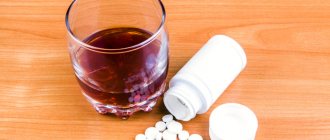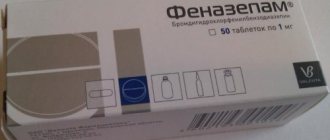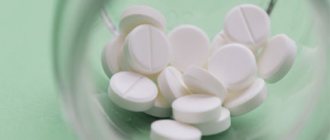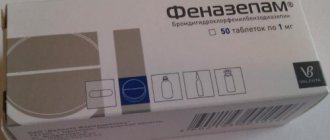The drug Phenazepam is a psychotropic drug that causes addiction. This drug is sold in pharmacies and is included in the list of narcotic drugs. It is illegal to buy Phenazepam without a prescription, and this puts the younger generation at risk.
There are many cases of hospitalization of adolescents with Phenazepam poisoning. As a medicine, this drug is used for sleep disorders, seizures, depression and anxiety disorders. There have also been cases of overdose and suicide attempts using Phenazepam.
Action of Phenozepam
The effect of Phenazepam when consumed in large quantities is a decrease in arousal, relaxation, euphoria, relief of tension and anxiety, and drowsiness. The sedative effect of Phenazepam is dangerous. It lies in the fact that when using the drug in large quantities, a person may lose consciousness and, if he is not helped, death will occur.
This is due to the fact that under the influence of Phenazepam, muscles relax, blood pressure decreases, and body temperature drops. A person is in a borderline state between sleep and wakefulness. When the effect of the drug wears off, the person experiences depression, depression, and loss of strength.
Relieving withdrawal symptoms at home
Medication-assisted withdrawal is a procedure to reduce pain during abrupt drug withdrawal. It is the first step in drug addiction treatment. Very often, drug addicts try to alleviate their condition with alcohol, but this only makes the situation worse. They begin to take sleeping pills and sedatives uncontrollably, thereby earning themselves cross-dependence, or switching to other stimulants. In 95% of cases, self-relief from withdrawal symptoms at home leads to the development of psychosis or a breakdown.
Treatment at home can only be carried out under the supervision of a narcologist.
, if the patient has not yet developed a stable addiction and intoxication passes with mild symptoms. The doctor will prescribe IVs with saline solutions and vitamins, painkillers, and drugs to strengthen the heart muscle. An important condition in home treatment is compliance with the drinking regime and control of urination.
To reduce the risk of severe consequences, treatment should be carried out in specialized clinics.
Overdose
Phenazepam is a tranquilizer . In case of an overdose, a person experiences symptoms similar to alcohol poisoning: nausea, vomiting, dizziness, headache, tremor. When tolerance to a drug increases, a person has a desire to achieve a euphoric state by using an increased dosage of the drug.
First aid for an overdose is to call a narcologist at home to remove toxic substances from the body. After stabilizing the physical condition, doctors recommend undergoing a course of treatment for psychological dependence.
Phenazepam
From the nervous system: at the beginning of treatment with the drug (especially in elderly patients), drowsiness, a feeling of fatigue, dizziness, decreased ability to concentrate, ataxia, disorientation, unsteady gait, slowed mental and motor reactions, confusion may occur; rarely - headache, euphoria, depression, tremor, memory loss, impaired coordination of movements (especially at high doses), depressed mood, dystonic extrapyramidal reactions (uncontrolled movements, including the eyes), asthenia, myasthenia, dysarthria, epileptic seizures (in patients with epilepsy); extremely rarely - paradoxical reactions (aggressive outbursts, psychomotor agitation, fear, suicidal tendencies, muscle spasms, hallucinations, agitation, irritability, anxiety, insomnia).
From the hematopoietic organs: leukopenia, neutropenia, agranulocytosis (chills, hyperthermia, sore throat, excessive fatigue or weakness), anemia, thrombocytopenia.
From the digestive system: dry mouth or drooling, heartburn, nausea, vomiting, loss of appetite, constipation or diarrhea; liver dysfunction, increased activity of liver transaminases and alkaline phosphatase, jaundice.
From the genitourinary system: urinary incontinence, urinary retention, renal dysfunction, decreased or increased libido, dysmenorrhea.
Allergic reactions: skin rash, itching.
Effect on the fetus: teratogenicity (especially the first trimester), central nervous system depression, respiratory impairment and suppression of the sucking reflex in newborns whose mothers used the drug.
Local reactions: phlebitis or venous thrombosis (redness, swelling or pain at the injection site).
Other: addiction, drug dependence; decreased blood pressure; rarely - visual impairment (diplopia), weight loss, tachycardia.
If the dose is sharply reduced or the drug is stopped, withdrawal syndrome develops (irritability, nervousness, sleep disturbances, dysphoria, spasm of smooth muscles of internal organs and skeletal muscles, depersonalization, increased sweating, depression, nausea, vomiting, tremor, perception disorders, including including hyperacusis, paresthesia, photophobia; tachycardia, convulsions, rarely - acute psychosis).
In case of overdose, severe drowsiness, prolonged confusion, decreased reflexes, prolonged dysarthria, nystagmus, tremor, bradycardia, shortness of breath or difficulty breathing, decreased blood pressure, and coma are possible. Gastric lavage, activated charcoal, symptomatic therapy (maintaining breathing and blood pressure), administration of flumazenil (in a hospital setting) are prescribed. Hemodialysis is ineffective.
Consequences of use
With chronic drug use , sleep disturbances, loss of appetite, depressive disorders, psychosis, panic attacks and obsessive fear, increased anxiety, irritability, hallucinations and delusions, and mental disorders occur.
Physical dependence on Phenazepam leads to withdrawal syndrome, overdose, and drug withdrawal. Psychological dependence leads to mental disorders, depression, and a depressed emotional state. The consequences of using Phenazepam are extensive and affect all areas of personal development.
Content:
- Withdrawal: what is it
- Withdrawal symptoms
- Relieving withdrawal symptoms at home
- Help with withdrawal symptoms
- Removing withdrawal symptoms in a hospital
Substance abuse leads to the development of drug addiction and damages physical and mental health, reduces a person’s ability to work and creative activity, and affects the well-being of the family.
This disease is common in various sectors of society. Drug addiction can also be developed after long-term treatment with addictive drugs (painkillers, sleeping pills). Drug intoxication suppresses the moral and mental regulators of human behavior and leads to the commission of crimes. As drug addiction progresses, a unique drug worldview is formed.
Dealing with drug addiction alone is very difficult. The desire to quit disappears out of fear of suffering during the period of drug withdrawal. Close people become the first witnesses of withdrawal symptoms. Seeing the severity of the patient’s condition, a search begins for ways to help relieve the drug addict’s withdrawal symptoms.
Addiction treatment
Treatment for addiction to Phenazepam is necessary if you experience signs of withdrawal, a psychological desire to use and cannot stop using the drug on your own. Contact the specialists of the Vasilenko Medical Center for help. Doctors will diagnose your physical and psychological condition and select an effective course of treatment for Phenazepam addiction.
Rehabilitation will help you get rid of psychological addiction and restore your physical and emotional state after using drugs. If you don’t know how to stop using drugs, trust the professionals!
Author:
Oleg Vasilievich Shevchenko
Withdrawal: what is it
Withdrawal syndrome or withdrawal is a complex of disorders of the functions of many organs and vital systems
. Occurs when the concentration of an intoxicating substance in the body decreases. This happens 7-8 hours after the last use of psychoactive substances. Pleasant sensations are replaced by painful ones.
Depriving a drug addict of the opportunity to continue using psychostimulants causes him to become depressed. All thoughts are only about finding a new dose. There is anxiety and irritability, a tendency to conflict.
At this moment, those who decide to quit drugs themselves have a breakdown.
The person begins to convince himself that he will now take the dose for the last time, and then he will be able to cope with withdrawal symptoms himself. This is the mistake that pulls him to the very bottom.
If the patient makes up his mind and does not take the drug, he begins to experience withdrawal symptoms, which gradually increase. At this moment, qualified help is needed. Often relatives try to treat a drug addict on their own. They use unverified advice, not realizing that relieving withdrawal symptoms at home worsens the patient’s condition and he will resume taking it in order not to suffer. Or there will be a threat to life, you will still have to contact doctors, but it will be too late.
Removing withdrawal symptoms in a hospital
Treatment in a clinic is considered the most effective and safe method in the fight against addiction. Experts know how to help a drug addict with withdrawal and how to properly relieve dangerous symptoms. Access to narcotic substances is completely excluded. The doctor can always adjust treatment measures based on the patient’s condition.
The detoxification procedure can reduce withdrawal time.
Toxins are eliminated faster, which greatly alleviates the condition and makes it possible to begin further treatment. The body receives vitamins and substances that restore the functioning of internal organs. Also, physiotherapy is used in the hospital, and work is carried out with psychologists.
If necessary, the following procedures are carried out:
- hemodialysis;
- hemosorption;
- plasmapheresis;
- pyrotherapy;
- insulin therapy.
To relieve withdrawal from opioid drugs, UBOD (ultra-rapid opioid detoxification) is used. It is performed under anesthesia, which allows you to stop the main manifestations in 2-3 days.
If medical assistance is not provided on time, psychosis, epilepsy, dementia, and depressive disorders may develop. The risk of suicide increases.
Medical use
Phenazepam is a 1,4-benzodiazepine, the same family of drugs that includes diazepam, oxazepam, and temazepam. Phenazepam was first synthesized and developed in 1975 in the Soviet Union, where since 1978 it has become one of the most common benzodiazepines used to treat sleep disorders, anxiety, alcoholism and epilepsy.
Phenazepam has not been licensed in other countries around the world. Limited use explains the paucity of peer-reviewed literature on the drug. The pharmacological profile of phenazepam corresponds to classical benzodiazepines. It reduces anxiety, seizures and motor activity. It is more effective than diazepam (about 5-10 times) and has more severe and long-lasting side effects. The effects of phenazepam can be mitigated by the selective benzodiazepine antagonist flumazenil.
In humans, phenazepam has a relatively long half-life of 60 hours, and side effects can last up to 5 days (some reports mention up to 3 weeks) after oral administration. It increases the duration of hexane-induced sleep several times and is superior to diazepam in this regard. Convulsions caused by high doses of metrazol (100 mg/kg) are completely prevented by phenazepam (1.4 mg/kg). In many clinical studies, phenazepam (0.0025 mg/kg) has shown greater and longer-lasting sedation than diazepam (0.005 mg/kg).
At a relatively high dose, phenazepam causes muscle hypotension, deep sleep and coma. Like other benzodiazepines, phenazepam is highly toxic when used concomitantly with other CNS depressants, especially opiates and alcohol, increasing the risk of respiratory depression and death. Various deaths have been reported after administration of phenazepam (confirmed analytically), mostly in combination with other CNS depressants.
Medicine knows cases of abuse of the drug. With relatively high dosages or prolonged use, signs of severe withdrawal are observed. Phenazepam is regularly found in contraband parcels seized by police or customs, indicating its widespread use for drug purposes.










